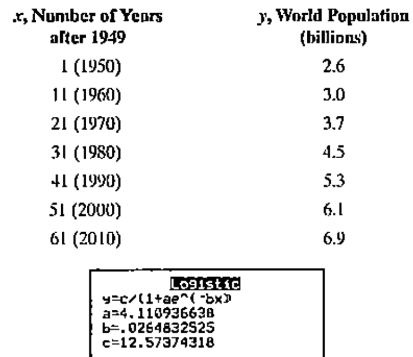
Concept explainers
Shown, again, in the following table is world population, in billions, for seven selected years from 1950 through 2010. Using a graphing utility's logistic regression option, we obtain the equation shown on the screen.

We see from the calculator screen at the bottom of the previous page that a logistic growth model for world population, f(x), in billions, x years after 1949 is
Use this function to solve Exercises 38-42.
How well does the function model the data showing a world population of 6.9 billion for 2010?
Want to see the full answer?
Check out a sample textbook solution
Chapter 4 Solutions
MYLAB FOR ALGEBRA & TRIGNOMERTY
- Use the quadratic formula to find the zeros of the quadratic equation. Y=3x^2+48x+180arrow_forwardM = log The formula determines the magnitude of an earthquake, where / is the intensity of the earthquake and S is the intensity of a "standard earthquake." How many times stronger is an earthquake with a magnitude of 8 than an earthquake with a magnitude of 6? Show your work.arrow_forwardNow consider equations of the form ×-a=v = √bx + c, where a, b, and c are all positive integers and b>1. (f) Create an equation of this form that has 7 as a solution and an extraneous solution. Give the extraneous solution. (g) What must be true about the value of bx + c to ensure that there is a real number solution to the equation? Explain.arrow_forward
- The equation ×+ 2 = √3x+10 is of the form ×+ a = √bx + c, where a, b, and c are all positive integers and b > 1. Using this equation as a model, create your own equation that has extraneous solutions. (d) Using trial and error with numbers for a, b, and c, create an equation of the form x + a = √bx + c, where a, b, and c are all positive integers and b>1 such that 7 is a solution and there is an extraneous solution. (Hint: Substitute 7 for x, and choose a value for a. Then square both sides so you can choose a, b, and c that will make the equation true.) (e) Solve the equation you created in Part 2a.arrow_forwardA basketball player made 12 out of 15 free throws she attempted. She wants to know how many consecutive free throws she would have to make to raise the percent of successful free throws to 85%. (a) Write an equation to represent this situation. (b) Solve the equation. How many consecutive free throws would she have to make to raise her percent to 85%?arrow_forwardA boat is 15 ft away from a point perpendicular to the shoreline. A person stands at a point down the shoreline so that a 65° angle is formed between the closest point to the boat, the person, and the boat. How far is the person from the boat? Round your answer to the nearest tenth of a foot. Show your work. boat 15 ft d 65° personarrow_forward
- 2. Find the value of x in the triangle. Round your answer to the nearest tenth of a degree. Show your work. 8 15arrow_forwardUse the equation x+2= √3x+10 to answer these questions. (a) What is the solution to the equation? (b) What is the extraneous solution? Why? (c) In general, what is an extraneous solution?arrow_forwardA utility pole is 35 ft tall. The pole creates a 50 ft shadow. What is the angle of elevation of the sun? Round your answer to the nearest degree. Show your work. nswer:arrow_forward
- Write the expression as a simplified rational expression. Show your work. 1 6 + 5 1 x + 1arrow_forwardThe population of a town was 5655 in 2010. The population grows at a rate of 1.4% annually. (a) Use the exponential growth model to write an equation that estimates the population t years after 2010. (a) Estimate the population of the town in 2022. Show your work.arrow_forwardSimplify the expression (x³ - 5x² + 7x - 12) ÷ (x − 4) using long division. Show your work.arrow_forward
 Algebra & Trigonometry with Analytic GeometryAlgebraISBN:9781133382119Author:SwokowskiPublisher:Cengage
Algebra & Trigonometry with Analytic GeometryAlgebraISBN:9781133382119Author:SwokowskiPublisher:Cengage Glencoe Algebra 1, Student Edition, 9780079039897...AlgebraISBN:9780079039897Author:CarterPublisher:McGraw Hill
Glencoe Algebra 1, Student Edition, 9780079039897...AlgebraISBN:9780079039897Author:CarterPublisher:McGraw Hill College Algebra (MindTap Course List)AlgebraISBN:9781305652231Author:R. David Gustafson, Jeff HughesPublisher:Cengage Learning
College Algebra (MindTap Course List)AlgebraISBN:9781305652231Author:R. David Gustafson, Jeff HughesPublisher:Cengage Learning Linear Algebra: A Modern IntroductionAlgebraISBN:9781285463247Author:David PoolePublisher:Cengage Learning
Linear Algebra: A Modern IntroductionAlgebraISBN:9781285463247Author:David PoolePublisher:Cengage Learning





